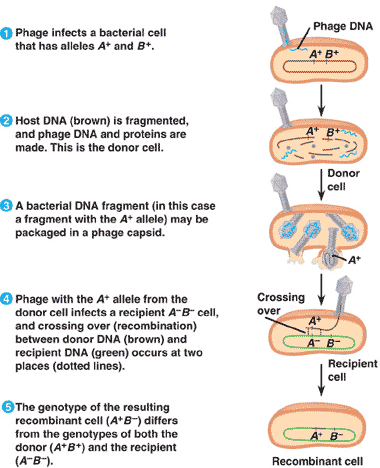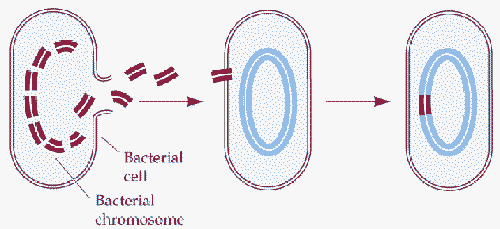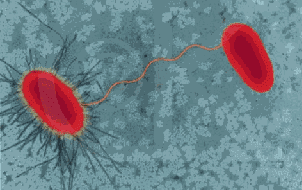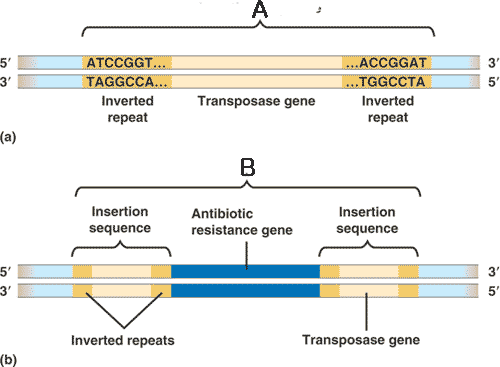| A | B |
|---|
| Describe a typical bacterial chromosome. | One double-stranded circular DNA molecule associated with a small amount of protein (below is a diagram of bacterial chromosome replication),  |
| The region of densely packed DNA in the ______ of a bacterium is called the ______. | cytosol, nucleoid |
| A small circular strand of DNA outside the bacterial chromosome is called a(n) _____. | plasmid (below is a diagram of a plasmid being transferred from one bacterial cell to another in a process called conjugation),  |
| Bacteria divide by an asexual process called ____. | binary fission |
| A unit of genetic function common in bacteria and phages, consisting of coordinately regulated clusters of genes with related functions. | operon (below is a diagram of the lac operon and the molecules that regulate its transcription),  |
| A bacterial plasmid carrying genes that confer resistance to certain antibiotics. | R-plasmid |
| A DNA segment that confers the ability to form pili for conjugation and associated functions required for the transfer of DNA from donor to recipient. It may exist as a plasmid or be integrated into the bacterial chromosome. | F-factor (below is a diagram of the F factor in plasmid form being incorporated into the bacterial chromosome, changing the cell from an F+ cell to an Hfr cell),  |
| The plasmid form of the F factor is called the _____. | F-plasmid (below is a diagram of the F factor in plasmid form being incorporated into the bacterial chromosome, changing the cell from an F+ cell to an Hfr cell),  |
| A genetic element that can move within a genome is called a(n) ______. | transposon,  |
| A method for recombination in bacteria in which a virus carries bits of DNA from one bacterium to another. | transduction,  |
| In prokaryotes, the direct transfer of DNA between two cells that are temporarily joined is called _____. | conjugation (can happen in eukaryotic ciliates also in a sexual process in which the two cells exchange haploid micronuclei),  |
| The change in genotype and phenotype due to the assimilation of external DNA by a cell. | transformation,  |
| What is the result when an F+ bacterium conjugates with an F- bacterium? | both cells are F+ after the conjugation,  |
| What is the result when an Hfr bacterium conjugates with an F- bacterium? | The F- bacterium becomes a recombinant F- bacterium (it doesn't become F+ or Hfr because the F factor is usually broken off before it can completely enter the F- bacterium. However, the transfer usually drags some of the Hfr's other chromosomal DNA with it),  |
The two bacteria in this photo have been caught in the act of ______. The long thing between them is a ______.,  | conjugation, pilus,  |
What is "B" in the picture below?,  | a transposon ("jumping gene"; They include extra genes that can transpose themselves into other parts of the genome, including the plasmid. This can be beneficial if the extra genes encode antibiotic resistance. Once in the plasmid, they can easily be transferred to other bacteria via conjugation. Eukaryotic organisms also have transposons),  |
| What are two general strategies for regulating metabolic pathways? | 1) Regulate the enzymes themselves. 2) Regulate the transcription of the enzymes.,  |
| What are three processes that bring together DNA from different bacteria? | transformation, transduction and conjugation |
| Under ideal conditions, an E. coli bacterium could reproduce every ____ minutes. | 20 |
| A bacterial cell that has an F factor encorporated into its chromosomal DNA is called a(n) ______ cell. | Hfr,  |
| A bacterial cell that has an F factor encorporated into a plasmid is called a(n) ______ cell. | F+,  |
| A promoter, an operator, and the genes they control make up a(n) _______. | operon,  |